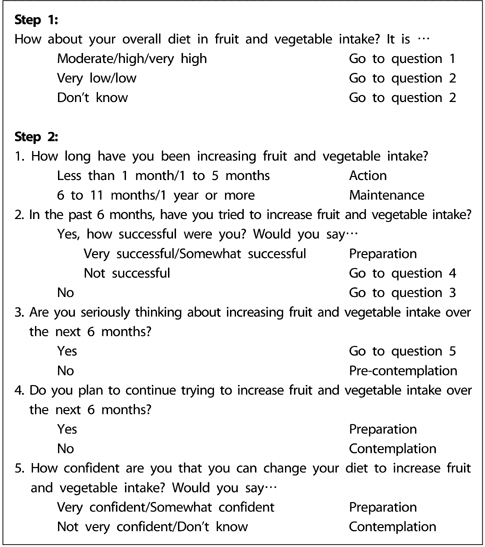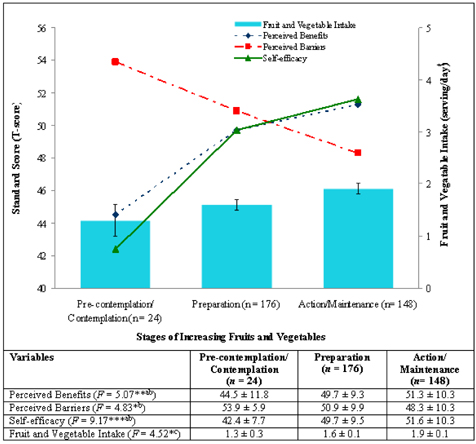Nutr Res Pract.
2014 Jun;8(3):297-303.
Stages of change to increase fruit and vegetable intake and its relationships with fruit and vegetable intake and related psychosocial factors
- Affiliations
-
- 1Department of Nutrition and Dietetics, Faculty of Medicine and Health Sciences, Universiti Putra Malaysia, 43400 UPM Serdang, Selangor Darul Ehsan, Malaysia. zalilahms@upm.edu.my
- 2Department of Food Science and Nutrition, Faculty of Applied Sciences, UCSI University, 56000 Cheras, Kuala Lumpur, Malaysia.
Abstract
- BACKGROUND/OBJECTIVES
Understanding individual's intention, action and maintenance to increase fruit and vegetable intake is an initial step in designing nutrition or health promotion programs. This study aimed to determine stages of change to increase fruit and vegetable intake and its relationships with fruit and vegetable intake, self-efficacy, perceived benefits and perceived barriers.
SUBJECTS/METHODS
This cross-sectional study was conducted among 348 public university staff in Universiti Putra Malaysia. A pre-tested self-administered questionnaire and two days 24-hour diet recall were used.
RESULTS
Half of the respondents (50%) were in preparation stage, followed by 43% in action/maintenance, 7% in pre-contemplation/contemplation stages. Respondents in action/maintenance stages had significantly higher self-efficacy (F = 9.17, P < 0.001) and perceived benefits (F = 5.07, P < 0.01) while respondents in pre-contemplation/contemplation and preparation stages had significantly higher perceived barriers (F = 4.83, P < 0.05). Perceived benefits tend to outweigh perceived barriers pre-ceding to taking action. Self-efficacy is important in motivating individuals to increase fruit and vegetable intake as self-efficacy and perceived barriers crossed over between preparation and action/maintenance. Respondents in action/maintenance stages had the highest adjusted mean serving of fruit and vegetable intake (F = 4.52, P < 0.05) but the intake did not meet recommendation.
CONCLUSION
Intervention strategies should emphasize on increasing perceived benefits and building self-efficacy by providing knowledge and skills to consume a diet high in fruits and vegetables in order to promote healthy changes in having high fruit and vegetable intake.
MeSH Terms
Figure
Reference
-
1. World Health Organization (CH). Food and Agriculture Organization (US). Diet, Nutrition and the Prevention of Chronic Diseases: Report of a Joint FAO/WHO Expert Consultation. WHO Technical Report Series No. 916. Geneva: Geneva: World Health Organization;2003.2. Blake M, Chaudhury M, Deverill C, Doyle M, Erens B, Falaschetti E, Hirani V, Moody A, Prescott A, Primatesta P, Shelton N, Stamatakis E, Wardle H. Joint Health Surveys Unit, National Centre for Social Research. Department of Epidemiology and Public Health at the Royal Free and University College Medical School. Health survey for England 2003. Volume 2. Risk factors for cardiovascular disease. In : Sproston K, Primatesta P, editors. Health Survey for England 2003. London: The Stationery Office;2004.3. Blanck HM, Gillespie C, Kimmons JE, Seymour JD, Serdula MK. Trends in fruit and vegetable consumption among U.S. men and women, 1994-2005. Prev Chronic Dis. 2008; 5:A35.4. Hall JN, Moore S, Harper SB, Lynch JW. Global variability in fruit and vegetable consumption. Am J Prev Med. 2009; 36:402–409.e5.
Article5. Disease Control Division. Malaysia NCD Surveillance-I 2005/2006: NCD Risk Factors in Malaysia. Putrajaya: Disease Control Division;2006.6. Ministry of Health Malaysia, Institute of Public Health (MY). National Health and Morbidity Survey 2011: Methodology and General Findings. Kuala Lumpur: Institute of Public Health;2011.7. Prochaska JO, DiClemente CC. Stages and processes of self-change of smoking: toward an integrative model of change. J Consult Clin Psychol. 1983; 51:390–395.
Article8. Greene GW, Fey-Yensan N, Padula C, Rossi S, Rossi JS, Clark PG. Differences in psychosocial variables by stage of change for fruits and vegetables in older adults. J Am Diet Assoc. 2004; 104:1236–1243.
Article9. Henry H, Reimer K, Smith C, Reicks M. Associations of decisional balance, processes of change, and self-efficacy with stages of change for increased fruit and vegetable intake among low-income, African-American mothers. J Am Diet Assoc. 2006; 106:841–849.
Article10. Ling AM, Horwath C. Defining and measuring stages of change for dietary behaviors: readiness to meet fruit, vegetable, and grain guidelines among Chinese Singaporeans. J Am Diet Assoc. 2000; 100:898–904.11. Chuan Ling AM, Horwath C. Perceived benefits and barriers of increased fruit and vegetable consumption: validation of a decisional balance scale. J Nutr Educ. 2001; 33:257–265.
Article12. Oh SY, Cho MR. Psychosocial characteristics of stages of dietary fat reduction among Korean adults. Ecol Food Nutr. 2002; 41:515–532.
Article13. Wong CY, Zalilah MS, Yap LD. Socio-demographic characteristics and nutritional status of individuals by stages of change for dietary fat reduction. Pak J Nutr. 2009; 8:1821–1829.
Article14. Campbell MK, Reynolds KD, Havas S, Curry S, Bishop D, Nicklas T, Palombo R, Buller D, Feldman R, Topor M, Johnson C, Beresford SA, Motsinger BM, Morrill C, Heimendinger J. Stages of change for increasing fruit and vegetable consumption among adults and young adults participating in the national 5-a-day for better health community studies. Health Educ Behav. 1999; 26:513–534.
Article15. Horacek TM, White A, Betts NM, Hoerr S, Georgiou C, Nitzke S, Ma J, Greene G. Self-efficacy, perceived benefits, and weight satisfaction discriminate among stages of change for fruit and vegetable intakes for young men and women. J Am Diet Assoc. 2002; 102:1466–1470.
Article16. Horwath CC. Applying the transtheoretical model to eating behaviour change: challenges and opportunities. Nutr Res Rev. 1999; 12:281–317.
Article17. Hearty AP, McCarthy SN, Kearney JM, Gibney MJ. Relationship between attitudes towards healthy eating and dietary behaviour, lifestyle and demographic factors in a representative sample of Irish adults. Appetite. 2007; 48:1–11.
Article18. Registrar of Universiti Putra Malaysia (MY). Statistic on the Staff in Universiti Putra Malaysia. Serdang: Universiti Putra Malaysia;2007.19. Ministry of Health Malaysia, Nation Coordinating Committee on Food and Nutrition. Malaysian Dietary Guidelines. Putrajaya: Nation Coordinating Committee on Food and Nutrition;2010.20. Kristal AR, Glanz K, Curry SJ, Patterson RE. How can stages of change be best used in dietary interventions? J Am Diet Assoc. 1999; 99:679–684.
Article21. De Vet E, de Nooijer J, de Vries NK, Brug J. The transtheoretical model for fruit, vegetable and fish consumption: associations between intakes, stages of change and stage transition determinants. Int J Behav Nutr Phys Act. 2006; 3:13.
Article22. Vereecken CA, Van Damme W, Maes L. Measuring attitudes, self-efficacy, and social and environmental influences on fruit and vegetable consumption of 11- and 12-year-old children: reliability and validity. J Am Diet Assoc. 2005; 105:257–261.
Article23. Cohen J. Statistical Power Analysis for the Behavioral Sciences. Rev. ed. San Diego (CA): Academic Press;1977.24. Rossi JS. Statistical power of psychological research: what have we gained in 20 years? J Consult Clin Psychol. 1990; 58:646–656.
Article25. Kloek GC, van Lenthe FJ, van Nierop PW, Mackenbach JP. Stages of change for fruit and vegetable consumption in deprived neighborhoods. Health Educ Behav. 2004; 31:223–241.
Article26. Laforge RG, Velicer WF, Richmond RL, Owen N. Stage distributions for five health behaviors in the United States and Australia. Prev Med. 1999; 28:61–74.
Article27. Kristal AR, Hedderson MM, Patterson RE, Neuhouser M. Predictors of self-initiated, healthful dietary change. J Am Diet Assoc. 2001; 101:762–766.
Article28. Potter JD, Finnegan JR Jr, Guinard JX, Huerta EE, Kelder SH, Kristal AR, Kumanyika S, Lin R, Motsinger BM, Prendergast FG, Sorensen G, Callahan KM. National Health Institute, National Cancer Institute. 5 a day for better health program evaluation report [Internet]. Bethesda (MD): National Health Institute, National Cancer Institute;2000. cited 2011 Sep 11. Available from: http://www.scgcorp.com/docs/5_a_Day_Booklet_sm.pdf.29. Shaikh AR, Yaroch AL, Nebeling L, Yeh MC, Resnicow K. Psychosocial predictors of fruit and vegetable consumption in adults a review of the literature. Am J Prev Med. 2008; 34:535–543.30. Lechner L, Brug J, De Vries H. Misconceptions of fruit and vegetable consumption: differences between objective and subjective estimation of intake. J Nutr Educ. 1997; 29:313–320.
Article31. Prochaska JO. Strong and weak principles for progressing from precontemplation to action on the basis of twelve problem behaviors. Health Psychol. 1994; 13:47–51.
Article32. Prochaska JO, Velicer WF, Rossi JS, Goldstein MG, Marcus BH, Rakowski W, Fiore C, Harlow LL, Redding CA, Rosenbloom D, Rossi SR. Stages of change and decisional balance for 12 problem behaviors. Health Psychol. 1994; 13:39–46.
Article33. Ôunpuu S, Woolcott DM, Rossi SR. Self-efficacy as an intermediate outcome variable in the transtheoretical model: validation of a measurement model for applications to dietary fat reduction. J Nutr Educ. 1999; 31:16–22.
Article34. Prochaska JO. Queries and request for articles [Internet]. Message to: Wong Chee Yen. 2012. 01. 12. cited 2012 Jan 13. Available from: https://aa-mg6.mail.yahoo.com/neo/launch?.rand=aa5lqk39htq56#4094606716. [about 1 screen].35. Ministry of Health Malaysia, Institute of Public Health (MY). The Third National Health and Morbidity Survey (NHMS III). Kuala Lumpur: Institute of Public Health;2008.36. Prochaska JO. Decision making in the transtheoretical model of behavior change. Med Decis Making. 2008; 28:845–849.
Article
- Full Text Links
- Actions
-
Cited
- CITED
-
- Close
- Share
- Similar articles
-
- The Effect of Nutrition Education on the Improvement of Psychosocial Factors Related to Vegetable and Fruit Intake of Elementary School Children in Pre-Action Stages
- Comparison of Mineral and Vitamin Intakes According to the Stage of Change in Fruit and Vegetable Intake for Elementary School Students in Chungnam Province
- Association of fruit and vegetable consumption with asthma: based on 2013–2017 Korea National Health and Nutrition Examination Survey
- Analysis of socio-demographic and dietary factors associated with fruit and vegetable consumption among Korean adolescents: use of data from the 7th and 8th Korea National Health and Nutrition Examination Survey (2016–2019)
- Prevalence and determinants of sufficient fruit and vegetable consumption among primary school children in Nakhon Pathom, Thailand



